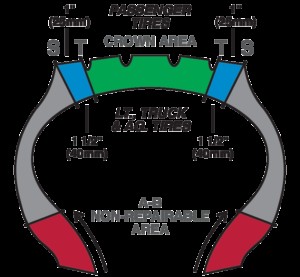Experiencing a flat tyre can be a frustrating and potentially dangerous situation for any driver. While quick fixes like tyre plugs and string repairs might seem like a convenient solution in an emergency, it’s crucial to understand that these are only temporary measures. For a safe and lasting solution, a proper car tyre puncture repair is essential. This guide will walk you through the correct methods for tyre repair, ensuring your safety and extending the life of your tyre.
Why Temporary Tyre Repairs Aren’t Enough
Many motorists mistakenly believe that if a tyre plug or string repair stops the leak, the tyre is safely repaired. While these methods can effectively reinflate your tyre and get you moving again, they fall short of providing a complete and secure repair. The primary issue with plug-only or string repairs is that they don’t fully seal the puncture channel from the inside.
The Hidden Dangers of Plug-Only Repairs
 the repairable are of most tires is restricted to the crown
the repairable are of most tires is restricted to the crown
When you use a plug to fix a puncture, you’re essentially inserting a foreign object into the tyre from the outside. Although this might stop air from escaping, it doesn’t address the damage within the tyre structure. This incomplete seal allows air and, more critically, moisture to penetrate the tyre’s internal layers. Over time, this moisture ingress can corrode the steel belts and weaken the tyre’s construction, potentially leading to a sudden and dangerous tyre blowout. Such a blowout, especially at high speeds, can result in loss of vehicle control and serious accidents.
The Shortcomings of Patch-Only Repairs
Similarly, relying solely on a tyre patch applied to the inside of the tyre is not a proper repair. While a patch can effectively seal air from escaping internally, it too fails to address the puncture channel itself. Just like plug-only repairs, patch-only solutions leave the puncture site vulnerable to air and moisture infiltration from the outside tread surface. This can lead to the same detrimental effects as plug-only repairs, compromising the tyre’s integrity and increasing the risk of failure.
The Industry-Standard Tyre Repair Process: The Patch-Plug Combination
To ensure a safe and durable tyre repair, industry guidelines mandate a combination patch-plug method. This process completely seals the puncture from the inside out, addressing both the inner liner and the puncture channel. To help remember the steps involved in a correct tyre repair, we use the acronym R.E.P.A.I.R.:
R – Remove the Tyre
The first crucial step is to remove the tyre from the wheel. This allows for a comprehensive inspection of both the interior and exterior of the tyre. Trying to repair a tyre while it’s still on the wheel is not only ineffective but also potentially dangerous, as it prevents a thorough assessment of the damage.
E – Evaluate the Damage
Once the tyre is detached from the wheel, a detailed evaluation of the puncture is necessary. This involves examining the size, direction, and angle of the puncture. It’s also essential to check for any internal damage to the tyre’s cords and belts. This evaluation determines if the tyre is indeed repairable and if the damage is within safe repair limits.
P – Prepare the Puncture Site
If the tyre is deemed repairable, the next step is to prepare both the puncture channel and the inner liner for the repair. Using a carbide cutter, the injury channel is carefully drilled out to remove any damaged cords or debris. The inner liner around the puncture is then cleaned and buffed to create a slightly rough surface. This preparation is vital for ensuring optimal adhesion of the repair unit.
A – Apply Vulcanizing Fluid
Vulcanizing fluid is then applied to the prepared puncture channel and the buffed area on the inner liner. This fluid acts as a chemical bonding agent, crucial for creating a strong and permanent seal between the tyre and the repair unit. The vulcanizing fluid needs to air dry for approximately 5 to 10 minutes to become tacky before proceeding to the next step.
I – Install the Patch-Plug
The next step involves installing a combination patch-plug repair unit. This unit is inserted through the puncture channel from the inside of the tyre, with the plug portion filling the puncture and the patch adhering to the inner liner. Using a tyre stitcher, the patch is firmly rolled onto the inner liner to eliminate any trapped air and ensure complete contact and adhesion. After installation, any excess plug material protruding from the tyre’s tread is trimmed, typically leaving about ¼ inch above the surface.
R – Return to Service
The final step is to remount the repaired tyre onto the wheel, inflate it to the correct pressure, and balance the wheel assembly. Once balanced, the wheel can be safely reinstalled on the vehicle, and the tyre is ready to return to service.
Is Your Tyre Repairable? Understanding the Limitations
Not all tyre punctures are repairable. Several factors determine whether a tyre can be safely repaired, primarily categorized by the location and size of the puncture, and the overall condition of the tyre.
Location of the Injury Matters
For passenger car tyres, repairs are only permissible within the crown area, which is the central tread area of the tyre. Damage to the shoulder or sidewall of the tyre is considered non-repairable due to the flexing and stress these areas endure during normal operation. Repairing sidewall or shoulder damage is highly unsafe and can lead to rapid tyre failure.
Size Restrictions for Punctures
The size of the puncture also dictates repairability. For standard fabric-ply passenger and light truck tyres, the maximum permissible puncture size for repair is ¼ inch (6mm). Steel-belted light truck, medium, and heavy-duty truck tyres can sustain slightly larger punctures, up to 3/8 inch (10mm). Punctures exceeding these size limits often indicate more significant internal damage and render the tyre unsafe for repair.
Overall Tyre Condition
Finally, the general condition of the tyre plays a crucial role in determining its repairability. Tyres with excessive wear, casing separation, impact damage, or previous improper repairs might not be suitable for repair. Attempting to repair a tyre that is already compromised can be dangerous. It’s always best to consult a tyre professional to assess the overall condition of your tyre and determine if a repair is a safe option. For more detailed information on repairable versus non-repairable tyre conditions, consult resources like “Can Your Tire Be Repaired?”.
Conclusion: Prioritise Proper Tyre Repair for Your Safety
Dealing with a flat or slow-leaking tyre is an inevitable part of driving. However, when it comes to repairs, shortcuts can compromise your safety and the safety of your passengers. Investing the time to ensure a proper tyre repair, or seeking out a reputable tyre repair shop that adheres to industry-standard procedures, is paramount. Always prioritize a complete patch-plug repair to guarantee a safe and lasting solution, ensuring peace of mind on the road.

